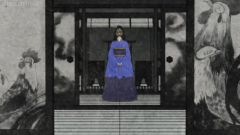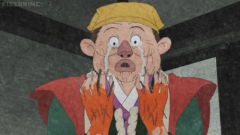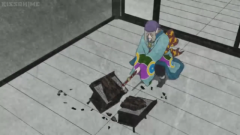And so ends another arc of Mononoke, in a way I never would have expected. As this week we solve a murder mystery, once again question our perceptions of the world, and get another new “favorite arc”. Apologies for the wait, sickness waits for no man, but let’s dive in.
Starting off, as always, the production of the episode. Mononoke has always had a strong visual direction, but this week was a treat. Both in terms of, mostly limited, animation and in direction. What with the usage of the bell to cut between scenes, or cutting angles in a scene to change the characters in it. There was a lot of very gripping imagery used throughout the episode that I thought connected well both in tone in content. My favorite part of the aesthetic though was the emphasis on color, and what it represented. Seemingly with each of the characters only gaining color as they felt strong emotions. Whether that be because of the scenes, or the events taking place. Based on how the episode finished up, I would suppose we could surmise that the color was linked to how “alive” or “real” they felt. Regardless though, it looked good.
Moving on to the actual content of the arc, this was another one that focused on perception. Though if the last one was in your perception of self/environment, this one is in terms of value. With the Todaiji and the Nue itself both embodying this concept. Each with multiple names, such as Rannatai with the Todaiji characters inside it, or the Nue in a more physical sense. Specifically with the Todaiji though, the focus was on perceived value. How no one but those in the “know” knew what it was worth, because other people has prescribed it such a value. To me, this connects back to money in our modern day. How our paper is effectively pointless, worthless, except we as a society have agreed to give it value. We have decided, collectively, to perceive printed paper as having value. When it does not have any inherently.
What was most interesting to this for me though was how it ended. With our Medicine Seller splitting the Todaiji itself and letting its scent free. Effectively freeing the trapped spirits, as what they had sought no longer had any value. Yet, this hunk of woods value inherently lay in its scent. So whatever value it has, it is worthless until you use it, until you burn the wood you cannot appreciate it. It connects back to money here for me. How pointless, how worthless, is money if you never spend it? If you have a million dollars in the bank, but never spend any of it on anything, you might as well have nothing. Because you are not making use of its value. It’s just sitting there, doing nothing. To me, it seems like Mononoke is saying that true value lies in experiences, rather simply “having” something.
Going back to the Nue for a moment, this comparison was really apt with the monster of the arc. How it was perceived differently by each of the cast. Some seeing the Princess, one a child and another the Old Woman. Kind of interesting how it uses the 3 major stages of a woman’s life there. The old “Mother, Maiden and Crone” approach from the three Fates of Greek myth. What I enjoyed most out of this comparison though was the use of the Nue’s myth. How each person saw a different piece of the Nue, and so thought it was that anime. Such as the monkey or snake and what not. Though unlike last time, where perception could change and any answer was correct, this time Mononoke tries a different path. With no singular answer being correct, and the truth only being found when you connected everyone’s viewpoints.
Moving on from all that though, however interesting it was, Mononoke pulled a fast one this week. I was rather surprised when the Medicine Seller started murdering the guests, as I thought he was being painted as the villain for once. But it made more sense as we went. With each of them already being dead upon arrival at the haunted house. With him only working to prove to each of them they were already dead. The sort of ghosts that thought they were still alive sort of shtick. It fits well with the use of colors and the direction of it all I felt. Though some of the execution was off. For instance the 4th suitor Jissonji was apparently already aware of his death. Meanwhile another had to be reminded that he killed the princess. That one didn’t quite land for me, I have to say.
All this considered though, this arc probably had some of the most terrifying imagery of Mononoke yet. With a lot of the ending horror in particular, with the environment and such, really sticking in my mind. It’s not the sort of jump-scare “aaaaah” horror though. This is much deeper. Sticking with you for longer, something you remember as you wake up the next day or creeps into your everyday life. Its a horror I much prefer, though that isn’t to say jump-scare horror doesn’t have value in itself. Its just two different flavors of horror, each trying to tickle a different part of the viewer. And just like flavors in food, each person will like a different kind of horror, with some not liking any kind at all.
So all in all, how was this episode and arc of Mononoke? Well in case it wasn’t made obvious, I quite enjoyed it. Every arc Mononoke has managed to one up itself with some new stylistic choice or style of presentation. The only thing I can really dock it for, aside from nitpicks, comes in its almost complete lack of animation. The series has an incredible reliance on still frames or minimal animation, which makes sense. As I don’t think its style would fit the sakuga laden Shounen series of late. But it feels to me like there could be more focus on the… character animation I suppose. More complex movements, facial expressions and such. A lot of minute details adding up instead of the explosive burst we see in action series. Still if I have to forego sakuga for a series like this, I will take it gladly.







